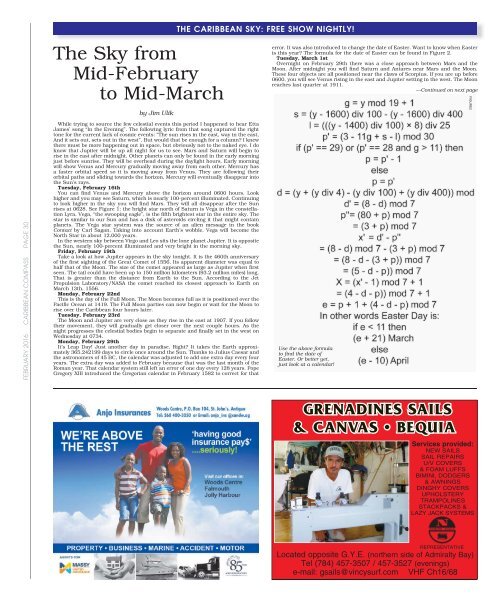Caribbean Compass Yachting Magazine February 2016
Welcome to Caribbean Compass, the most widely-read boating publication in the Caribbean! THE MOST NEWS YOU CAN USE - feature articles on cruising destinations, regattas, environment, events...
Welcome to Caribbean Compass, the most widely-read boating publication in the Caribbean! THE MOST NEWS YOU CAN USE - feature articles on cruising destinations, regattas, environment, events...
Create successful ePaper yourself
Turn your PDF publications into a flip-book with our unique Google optimized e-Paper software.
The Sky from<br />
Mid-<strong>February</strong><br />
to Mid-March<br />
by Jim Ulik<br />
THE CARIBBEAN SKY: FREE SHOW NIGHTLY!<br />
error. It was also introduced to change the date of Easter. Want to know when Easter<br />
is this year? The formula for the date of Easter can be found in Figure 2.<br />
Tuesday, March 1st<br />
Overnight on <strong>February</strong> 29th there was a close approach between Mars and the<br />
Moon. After midnight you will find Saturn and Antares near Mars and the Moon.<br />
These four objects are all positioned near the claws of Scorpius. If you are up before<br />
0600, you will see Venus rising in the east and Jupiter setting in the west. The Moon<br />
reaches last quarter at 1911.<br />
—Continued on next page<br />
FIGURE2<br />
FEBRUARY <strong>2016</strong> CARIBBEAN COMPASS PAGE 30<br />
While trying to source the few celestial events this period I happened to hear Etta<br />
James’ song “In the Evening”. The following lyric from that song captured the right<br />
tone for the current lack of cosmic events: ”The sun rises in the east, way in the east,<br />
And it sets out, sets out in the west”. But would that be enough for a column? I knew<br />
there must be more happening out in space, but obviously not to the naked eye. I do<br />
know that Jupiter will be up all night for us to see. Mars and Saturn will begin to<br />
rise in the east after midnight. Other planets can only be found in the early morning<br />
just before sunrise. They will be overhead during the daylight hours. Early morning<br />
will show Venus and Mercury gradually moving away from each other. Mercury has<br />
a faster orbital speed so it is moving away from Venus. They are following their<br />
orbital paths and sliding towards the horizon. Mercury will eventually disappear into<br />
the Sun’s rays.<br />
Tuesday, <strong>February</strong> 16th<br />
You can find Venus and Mercury above the horizon around 0600 hours. Look<br />
higher and you may see Saturn, which is nearly 100-percent illuminated. Continuing<br />
to look higher in the sky you will find Mars. They will all disappear after the Sun<br />
rises at 0628. See Figure 1: the bright star north of Saturn is Vega in the constellation<br />
Lyra. Vega, “the swooping eagle”, is the fifth brightest star in the entire sky. The<br />
star is similar to our Sun and has a disk of asteroids circling it that might contain<br />
planets. The Vega star system was the source of an alien message in the book<br />
Contact by Carl Sagan. Taking into account Earth’s wobble, Vega will become the<br />
North Star in about 12,000 years.<br />
In the western sky between Virgo and Leo sits the lone planet Jupiter. It is opposite<br />
the Sun, nearly 100-percent illuminated and very bright in the morning sky.<br />
Friday, <strong>February</strong> 19th<br />
Take a look at how Jupiter appears in the sky tonight. It is the 460th anniversary<br />
of the first sighting of the Great Comet of 1556. Its apparent diameter was equal to<br />
half that of the Moon. The size of the comet appeared as large as Jupiter when first<br />
seen. The tail could have been up to 150 million kilometers (93.2 million miles) long.<br />
That is greater than the distance from Earth to the Sun. According to the Jet<br />
Propulsion Laboratory/NASA the comet reached its closest approach to Earth on<br />
March 13th, 1556.<br />
Monday, <strong>February</strong> 22nd<br />
This is the day of the Full Moon. The Moon becomes full as it is positioned over the<br />
Pacific Ocean at 1419. The Full Moon parties can now begin or wait for the Moon to<br />
rise over the <strong>Caribbean</strong> four hours later.<br />
Tuesday, <strong>February</strong> 23rd<br />
The Moon and Jupiter are very close as they rise in the east at 1907. If you follow<br />
their movement, they will gradually get closer over the next couple hours. As the<br />
night progresses the celestial bodies begin to separate and finally set in the west on<br />
Wednesday at 0734.<br />
Monday, <strong>February</strong> 29th<br />
It’s Leap Day! Just another day in paradise. Right? It takes the Earth approximately<br />
365.242199 days to circle once around the Sun. Thanks to Julius Caesar and<br />
the astronomers of 45 BC, the calendar was adjusted to add one extra day every four<br />
years. The extra day was added to <strong>February</strong> because that was the last month of the<br />
Roman year. That calendar system still left an error of one day every 128 years. Pope<br />
Gregory XIII introduced the Gregorian calendar in <strong>February</strong> 1582 to correct for that<br />
Use the above formula<br />
to find the date of<br />
Easter. Or better yet,<br />
just look at a calendar!<br />
GRENADINES<br />
SAILS<br />
& CANVAS • BEQUIA<br />
Services provided:<br />
NEW SAILS<br />
SAIL REPAIRS<br />
U/V COVERS<br />
& FOAM LUFFS<br />
BIMINI, DODGERS<br />
& AWNINGS<br />
DINGHY COVERS<br />
UPHOLSTERY<br />
TRAMPOLINES<br />
STACKPACKS &<br />
LAZY JACK SYSTEMS<br />
REPRESENTATIVE<br />
Located opposite G.Y.E. (northern side of Admiralty Bay)<br />
Tel (784) 457-3507 / 457-3527 (evenings)<br />
e-mail: gsails@vincysurf.com VHF Ch16/68


















